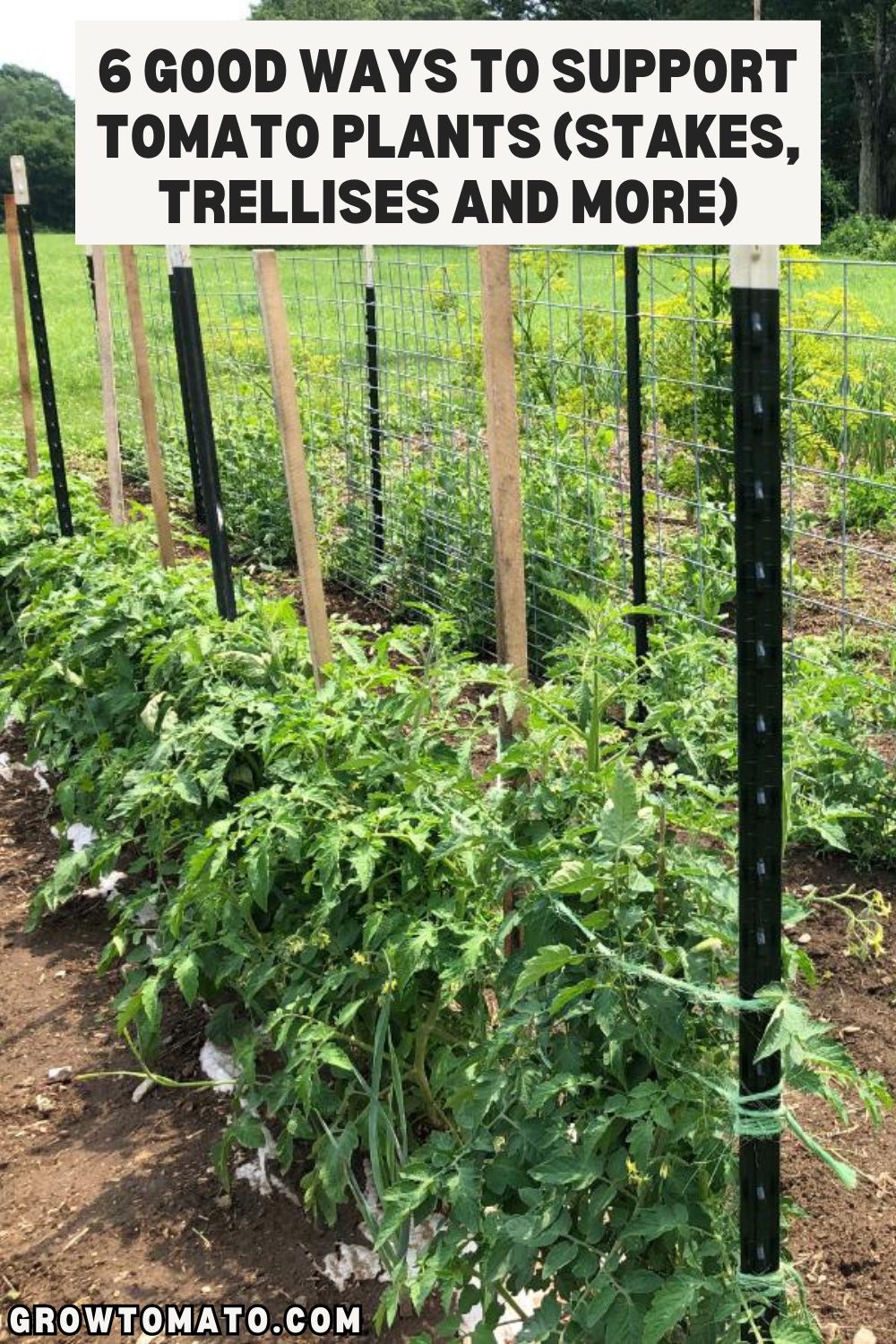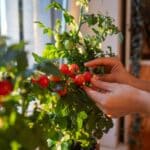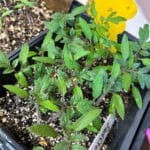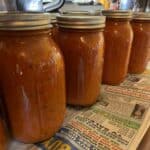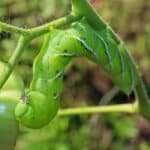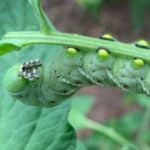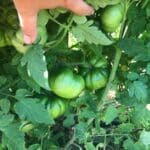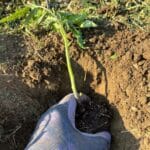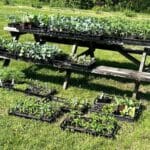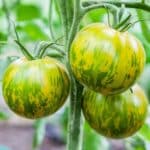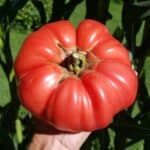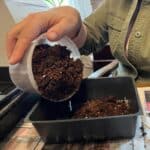With the exception of dwarf plants, most tomato plants need to be supported. Where there used to be only a couple of options for doing this, we now have several good ways to support tomatoes.
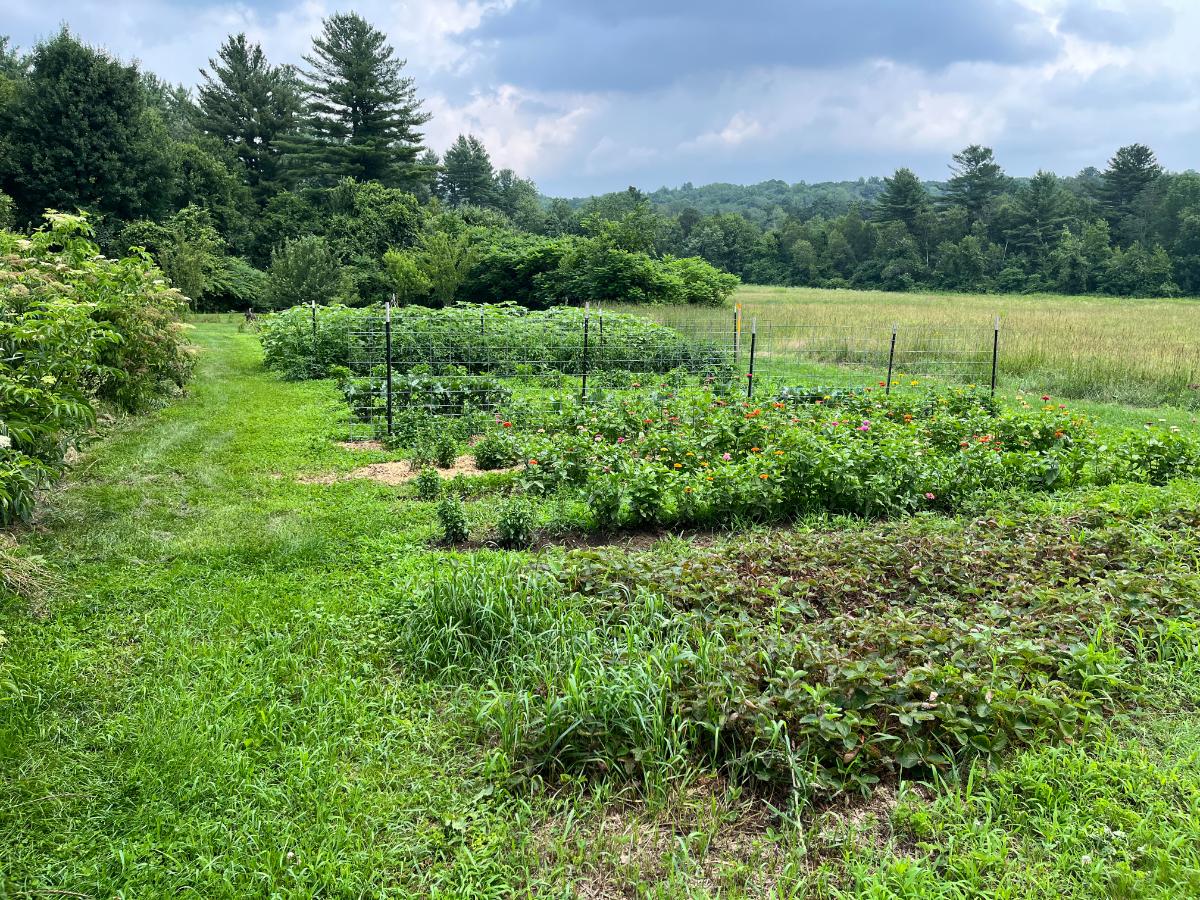
The right choice for you will depend on what type of tomatoes you are growing, how many, and the amount of gardening or container space you have.
Below, we’ve listed six of the best and easiest ways to support tomatoes for good growth, plant and fruit health.
Jump to:
1. Tomato Stakes

Tomato stakes are simple. You will use one strong, tall stake per plant, which is staked into the ground when you plant your tomatoes (or even before).
With stakes, the tomato is planted about six inches from the stake and then tied to the stake as the tomato plant grows.
Choose a stake that will be tall enough to support your tomatoes through their whole lifespan. Check the height on your tomato variety, and plan accordingly.
Keep in mind, for strength, you need to drive your stakes into the ground 10 to 12 inches. That means that you need a stake that is at least one foot taller than what the expected mature plant height is.
For determinate tomatoes, a four-foot stake will usually suffice. For indeterminate, choose at least a six-foot stake.
Tomato stakes work best for:
- Compact size determinate varieties (though bushing can make stakes difficult to deal with)
- Indeterminate varieties that are pruned and trained to a single-stem
- Varieties that don’t get above 5 to 6 feet tall or that you plan to top at that size
Some advantages of using tomato stakes:
- They're cheap
- Usually readily available
- Easy to bring home, even in a car
- You can make your own from long, thin, sturdy branches or saplings
- Easy for one person to install
- Easy to use for crop rotation as they are not a permanent or semi-permanent installation
2. Tomato Cages

Tomato cages are placed over the tomato plant when it is planted. As the plant grows, it grows and branches up and through the tomato cage. Graduated rings on the cage give support to fruit and branches as they grow out and through the cage.
Tomato cages work best for plants that you don’t plan to prune. It can be hard to prune tomato plants inside the cage. The cages are somewhat expensive, but they will last for many years (more if you store them indoors in winter) and can be reused every year.
Tomato cages come in different sizes, starting at around four feet tall and going up from there. Make sure you choose a cage size that will accommodate the size of the tomato variety you are growing. Keep in mind that the bottom 6 to 12 inches will be sunk into the ground to hold the cage and anchor the cage and tomato plant.
Tomato cages are not ideal for very large or tall plants and can sometimes be difficult to use with indeterminate tomato varieties. Indeterminate tomatoes grow as continuously growing vines, and very large and vigorous bushes sometimes weigh and bend the cages or push and pull the cages out of the ground.
Many cages are not large enough to support large, indeterminate varieties. If you find them, spend the money for the larger cages to house your large tomato plants.
Some advantages of using tomato cages:
- Easily reused and last for many years
- Usually made of metal or coated metal, and are easily cleaned and disinfected (as opposed to wood that is porous and may harbor pathogens from one year to the next)
- Easy for a single person to install
- Easily removed in the fall for winter storage
- Easy to use for crop rotation as they are not a permanent or semi-permanent installation
Tomato cages work best for:
- Tomatoes that you don’t plan to prune
- Determinate varieties that top out between 4 and 6 feet
- Bushing tomatoes (usually determinate) or tomatoes with more than one stem that are difficult to train to a single support system like a stake
3. Cattle Panel Fence Panels

Cattle panels have become quite popular with home gardeners and market growers, for good reason: they are versatile and useful in many ways; they make great fences and trellis-style supports; they are cleanable; they are sturdier than rolled wire; they are rigid and do not bend much under plant weight.
As a support for tomatoes, cattle panels can be used in a couple of ways.
- You can create an arched trellis that indeterminate, vining varieties can climb over (but should still be attached and tied at points).
- You can also make a fence-line style of support (similar to a pea fence) and then plant the tomatoes next to the panel and tie them to the panels as they grow. They’re strong enough that you can weave plants through the large (6-inch) square openings, similar to how growing through a cage works.
Any type of tomato can be grown on a cattle panel fence, but you might find it more difficult to tie up bushy determinate types and unpruned indeterminate varieties (if you’re patient enough, though, you can weave young plant tops through and tie branches to the panels, too).
The average standard height for cattle panels is four or five feet (and usually 16 feet long). They will need to be mounted on strong posts; metal T posts work well. Since they are mounted, the panels don’t need to be sunk into the ground, so you don’t lose height there.
You can also lift the panels up 6 to 12 inches when you mount them and gain an extra foot of trellis height, so you can potentially have a cattle panel tomato fence that is 5 or 6 feet tall. That makes them more useful for more tomato varieties. A six-foot fence will be large enough for almost all types of tomatoes.
The panels themselves are an investment, but they last for many years and are reusable. They are a semi-permanent installation that you won’t really want to have to move every year, so they can create some issues for crop rotation, but you can also use the panels for other fencing and growing supports.
So, for example, you might keep three fences in the garden and rotate what gets grown on them – peas one year, tomatoes the next, and vining cucumbers, squash, or beans in another year.
Some advantages of using cattle panel tomato fences:
- Sturdy and long-lasting
- Will support the most vigorous of plants
- Strong enough not to bend or act like a sail in the wind
- Not likely to fall over in high winds if properly anchored
- Semi-permanent and don't need to be removed for winter
- Cleanable
- Can be used in rotation with other crops that need fences or support like peas, squash, pole beans, etc.
Cattle panel tomato fences work best for:
- Most varieties of tomatoes, but slightly better for pruned indeterminate varieties than they are for bushy determinates
4. Woven/Welded Wire Fencing
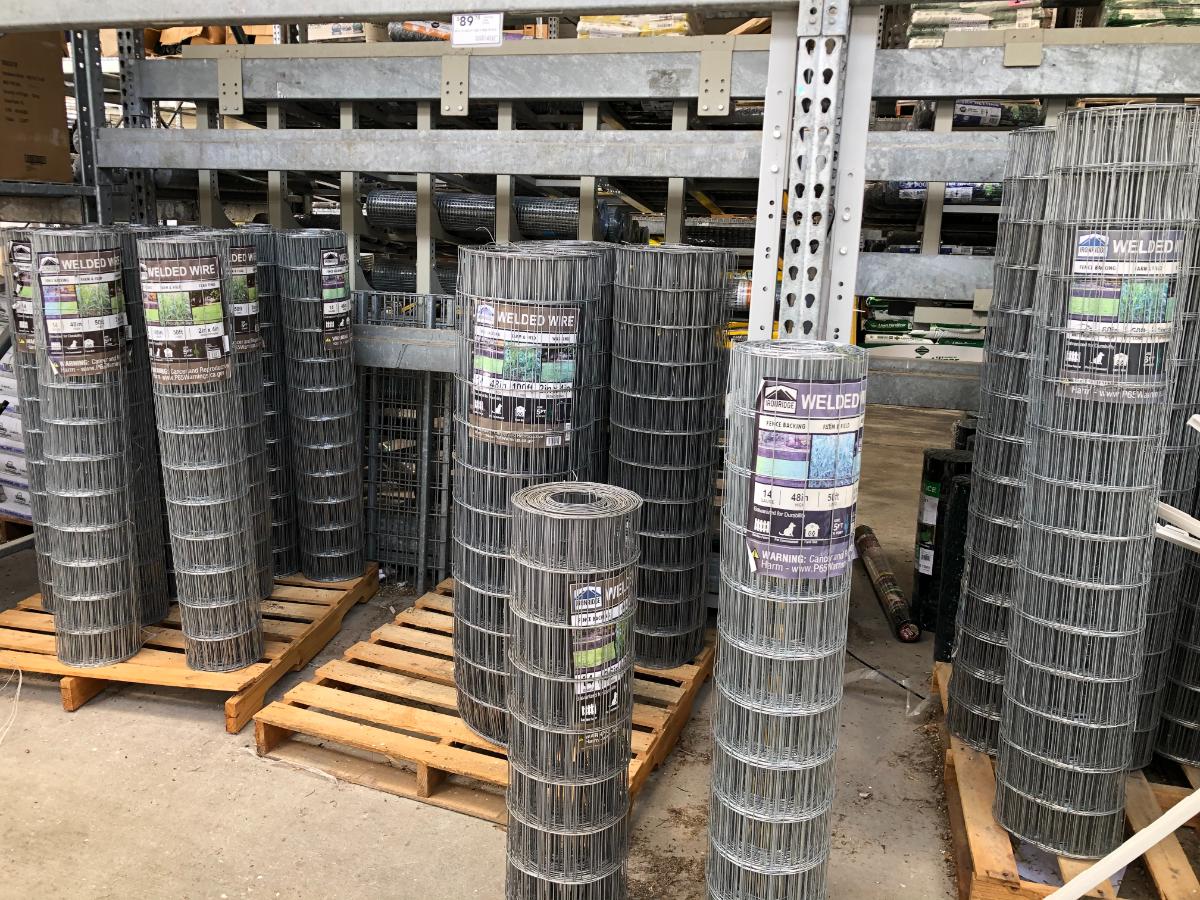
Woven or welded wire would be used, similar to how a cattle panel fence would be used. You would need to install a strong fence or T-posts, then attach the wire to them and tie the tomatoes to the wire as they grow.
One thing to note about wire fencing is that it is less sturdy and more bendable than cattle panels, so it is not the best choice for large and vigorous growers. On the other hand, that makes it easier for you as a grower to install, especially if you don’t have help.
Woven wire or welded wire is a better choice for some gardeners because it comes in rolls that are lighter and easier to transport and is readily available at most any hardware or home and garden center.
The key to success with woven wire is to make sure it has good foundational anchoring and is stretched tight so that it supports the plants and does not bend under their weight.
Like cattle panels, this would be a semi-permanent installation that could make rotating your tomatoes to new spaces in the garden difficult, but it can also be used for other types of plants and achieve crop rotation that way.
Some advantages of using woven or welded wire fencing for tomato supports:
- Cheaper than cattle panels
- Easier to lift and maneuver
- Lighter than panels
- Rolls can be transported in a car
- Semipermanent and does not need to be removed for winter
- Cleanable
- Can be used in crop rotation for other crops that need support or fencing, like peas and vining plants and vertical growing
Woven and welded wire fences work best for:
- Smaller indeterminate varieties that are pruned to reduce foliage so they don’t bend the wire over or create a sail in the wind
- Determinate varieties if you can keep up with tying the plants to the wire (the number of branches and foliage can be difficult for determinate tomatoes, though)
5. Florida Weave
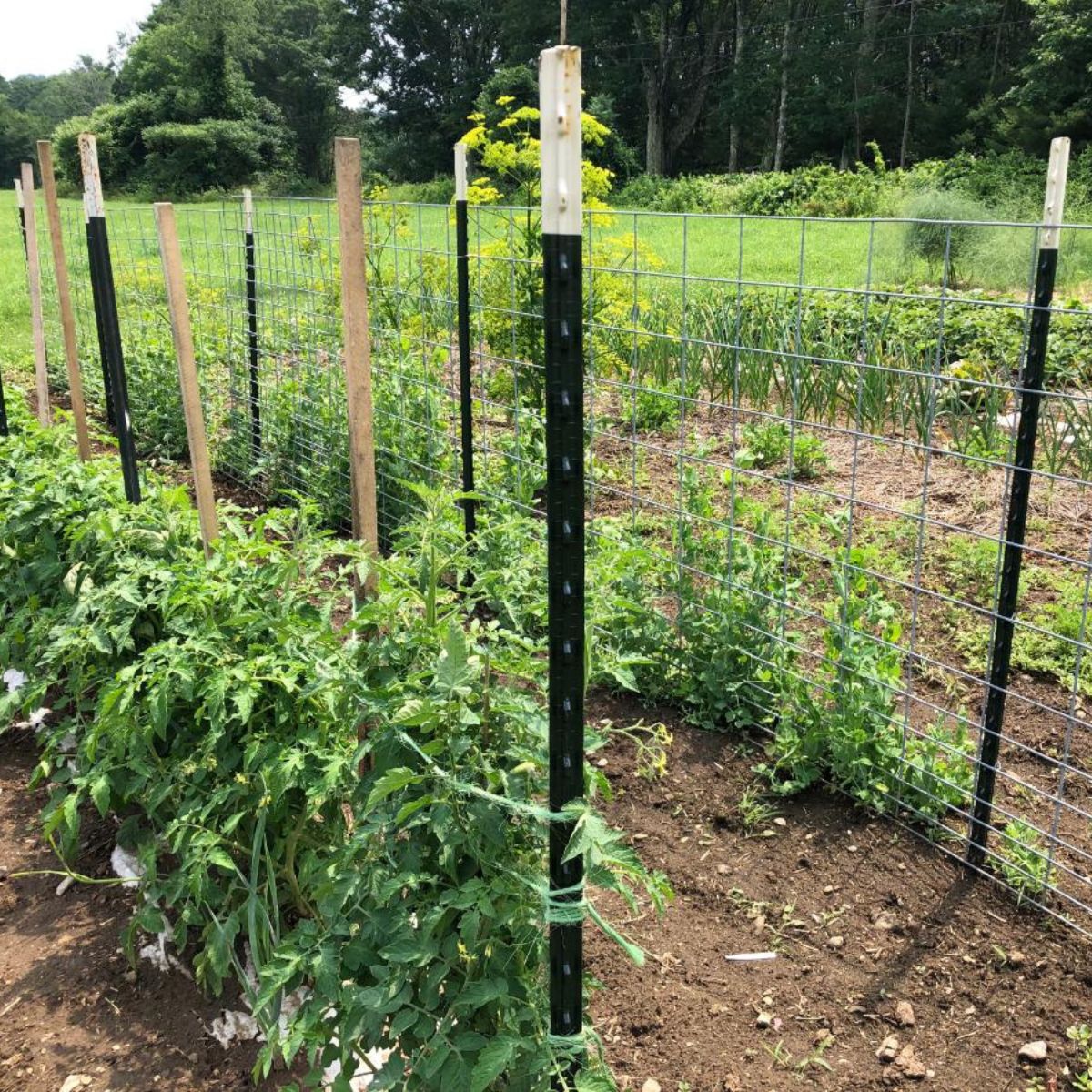
The Florida Weave is a system where you put fence posts or stakes in the ground and then weave strong twine or cord between the plants, creating a sort of self-supporting basket weave in which the stakes, posts, and the plants themselves all work together to support the tomato patch.
To sum up how to use the Florida Weave, you will drive metal T-posts into the ground on each end of the run, then drive a wooden tomato stake into the ground either between each plant or every two or three plants.
Note that the stakes are not set next to the tomato plants as tomato stakes would be – the tomatoes don’t get tied to the posts or stakes; the twine does.
Each week, as the plants grow, you weave in a new run of rope/cord or twine. This envelopes the plants and holds them up between the two sides of the weave. You weave and out between the plants, including the posts and stakes in the weave. This creates one large support unit for all the plants in the run.
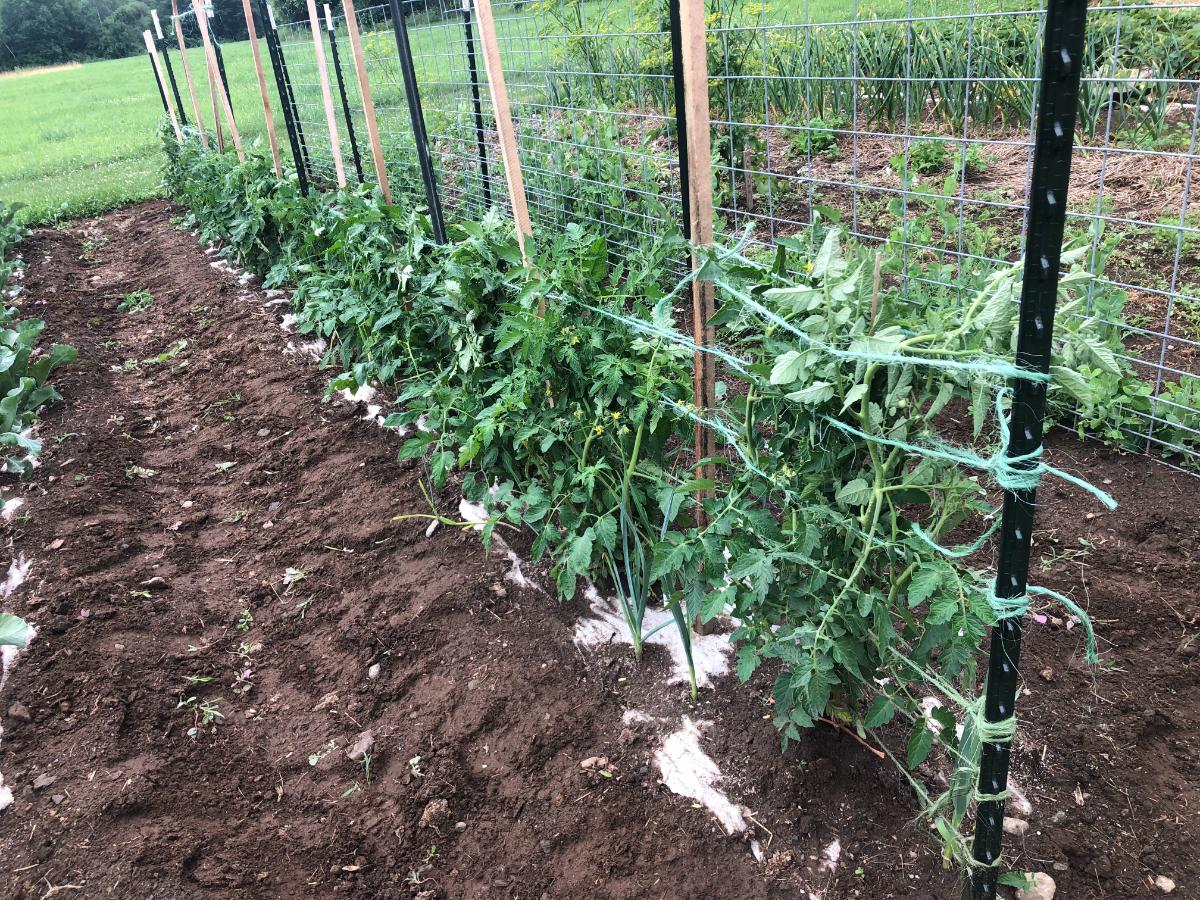
The Florida Weave is most popular with determinate varieties that do not get pruned and that do not grow too tall. Your plants should not be of a variety that will grow taller than your posts or stakes by too much. It can be used for indeterminate varieties, but pruning would be difficult.
One thing to note is that you need all the plants in each weave to be the same in growth rate and height. Otherwise, some plants will need weaving before others, and it is too hard to keep a consistent, supporting weave as the tomatoes grow.
For this reason, it is best to do weaves in sections of all the same type of plant, or at least varieties that grow at the same pace and to the same height.
The posts and stakes should be installed before the tomatoes are planted. The weave should be started once the plants are 10 to 12 inches high when they start needing support, and start bushing out.
Some advantages of using the Florida Weave tomato support:
- Easy to handle and transport supplies
- It's fast “tying” up tomato plants because you are not tying individual plants – you weave around the plants, which takes only a few minutes, even for a long row
- Plants and stakes work together to create one large support system
- Stakes and posts can be reused each year
- Twine or cord can be burned or composted with tomato vines in the fall/winter (if you use one made of natural or compostable materials – baling twine works well)
Florida Weave works best for:
- Shorter, bushing varieties of tomato
- Primarily for determinate varieties
- Runs of all the same type of tomato or tomatoes with the same growth rate (days to maturity) and height
- Tomatoes that are not being pruned
6. Trellising with Twine
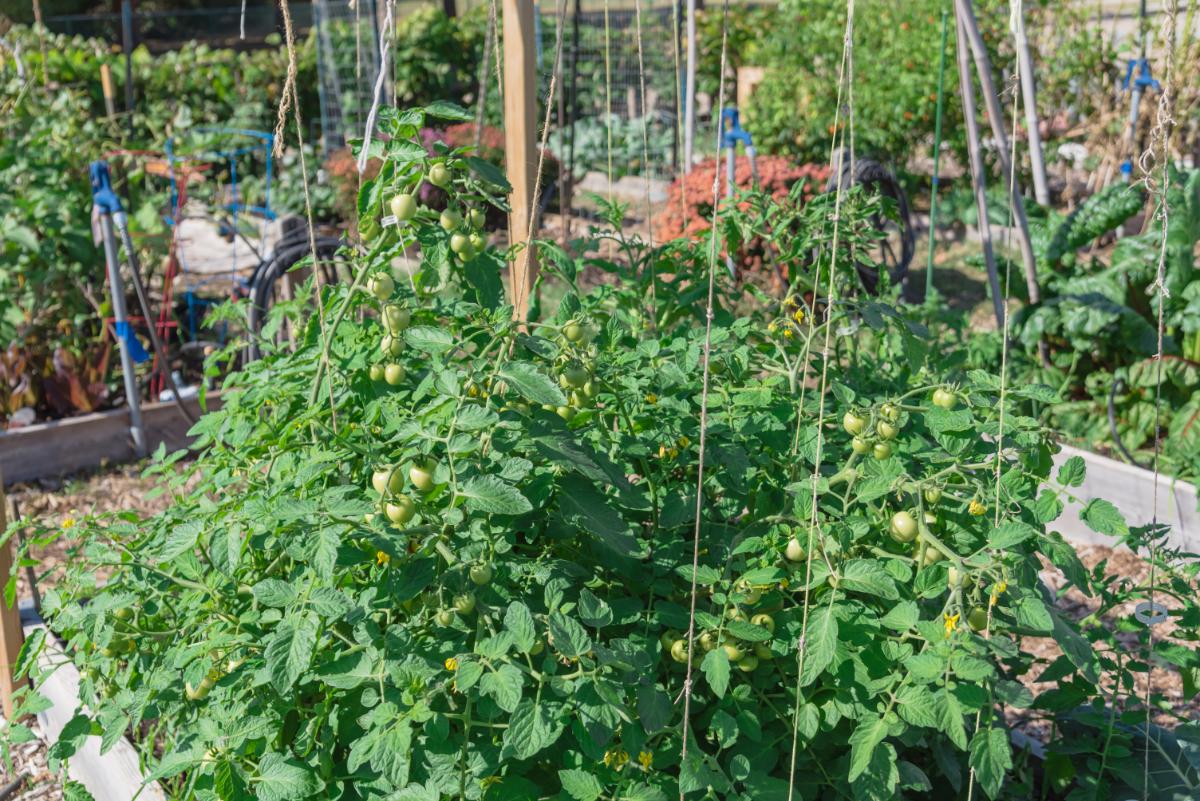
Trellising with twine is a system that is gaining in popularity. In this system, you will need to build a strong, tall framework that is taller than the height of the tomatoes. Several lines (of thick twine) will be tied to the top of the frame and dropped down at the intervals where the tomatoes will be planted.
The frame needs to be installed before any planting is done. It is easiest to install the twine lengths before you plant the tomatoes (so you’re not climbing over the plants). Place the twine at the right spacing for each plant. In other words, place twine at each planting spot.
The twine should reach all the way to the ground with a couple of extra inches to start the tie.
After you plant each tomato, tie a loose loop around near the base of the plant. From there, you have two options: you can either twist the twine around the stem of the plant and continue to do that as it grows, or you can use tomato clips to clip the stem to the twine.
The plants should be twisted or tied up at least once per week. Don't wait too long or you are likely to break stems as you twist or tie.
This system is really only practical for tomatoes that will be pruned and trained to a single stem, which means it is to be used with indeterminate types of tomatoes. It would be a difficult system to use with bushing tomatoes (determinate varieties) and unpruned tomatoes because the only support is one thin length of twine.
Some advantages of using twine trellises for tomatoes:
- Twisting and tying is fairly simple and quick
- Ties can be installed by one person and require no heavy lifting (after the frame is built, of course)
- Individual plants can grow and be tied at their own pace
- Twine is cheap (though the framework is an investment)
- Wooden frame is reusable year after year
- There's no real limit to the height of the plant that can supported, so plants that outperform can still be supported with the system
Twine trellis tomato supports work best for:
- Indeterminate tomatoes
- Pruned varieties
- Single stem tomatoes
Tips for Making or Choosing Tomato Ties
- For your ties, use something wider than string
- Baling twine or thick garden twine are good options
- It’s best if your twine is at least ¼ inch thick so it doesn’t cut into the stems of your tomato plants
- Old tee shirts cut into strips (about ½ to 1 inch wide) make excellent ties for tomatoes – they are strong enough but with enough give not to damage plants
- You can also buy tomato ties; some good options are tomato clips, garden velcro, or rolls of garden twist ties
Tips for Tying Tomato Ties
- Keep the ties loose so the plant has some room to move and grow and you don’t cut or injure the plant stem
- Tie ties in a figure 8 pattern – this helps them stay in place and gives better support without direct pulling and pressure on the stem
- You will have to tie up new growth every week
- Try not to skip a week of tying!
- Tie new top growth while it is still small and pliable
- If you wait to tie new growth, you’re bound to break or damage tops, or they may fall over and snap off from their own weight if they’re not supported early enough
- Install new ties for about every six inches of growth
